Kubernetes (K8s) Monitoring
Kubernetes (K8s) Monitoring with Centreon: Comprehensive Solutions for Efficient Container Management
OVERVIEW
Understanding Kubernetes Monitoring
Kubernetes, commonly referred to as K8s, is an open-source platform designed for the automation of deploying, scaling, and managing containerized applications. Originally developed by Google, Kubernetes has rapidly become the leading container orchestration tool. It provides a reliable and flexible framework for managing distributed applications, making it a core technology for modern cloud-native development.
With features like self-healing, load balancing, and automated rollouts, Kubernetes ensures high availability and resilience for applications. However, due to the complexity and scale of containerized environments, monitoring all aspects of a Kubernetes infrastructure is critical to maintain performance, security, and cost-efficiency.
Why Monitoring Kubernetes is Critical
Kubernetes manages distributed and often complex infrastructures, requiring visibility at every layer to prevent performance issues, optimize resources, and troubleshoot problems. With many applications delivered in containers, monitoring becomes essential to ensure the health of the entire ecosystem. Key monitoring areas include:
Node Health
Kubernetes nodes run the containerized applications. Monitoring the health of each node is crucial for detecting issues such as high CPU or memory usage that may lead to performance bottlenecks. Tracking node health ensures that resources are appropriately allocated and that no node is overburdened.
Pod Health
Each node in Kubernetes contains one or more pods, which are the smallest deployable units in Kubernetes. Monitoring pod health includes tracking the restart counts, readiness and liveness probes, and identifying unresponsive or failed pods.
Resource Usage
Monitoring CPU and memory usage at both the node and pod level is crucial to prevent resource exhaustion. Efficient resource utilization helps avoid performance degradation and ensures that applications run smoothly.
Network Performance
Kubernetes relies heavily on smooth network communication between pods and services. Monitoring network performance, including latency, throughput, and errors, ensures that the network does not become a bottleneck.
Service Availability
Ensuring that Kubernetes services, including load balancers, are available and performing optimally is essential for application uptime. Monitoring the health of these services allows for proactive troubleshooting and failure detection.
Cluster Events
Kubernetes generates events that provide insights into the health of the cluster. Monitoring warnings and errors helps to identify underlying issues, such as resource constraints or scheduling problems, that may affect overall performance.
Storage Metrics
Storage plays a crucial role in any Kubernetes environment. Monitoring the health and performance of persistent storage volumes ensures that data remains accessible and reliable. Poor storage performance can lead to application failures and slowdowns.
Security Logs
Kubernetes clusters need to be secure. Monitoring security events and logs is essential to detect any unauthorized access attempts or policy violations. This helps to protect the infrastructure from malicious attacks or breaches.
Application Metrics
Monitoring application-specific metrics such as request latency, error rates, and user interactions provides insights into how the application performs from the user’s perspective. These metrics help identify performance bottlenecks and improve the user experience.
Kubernetes Delivery Models
Kubernetes can be implemented in various ways, and monitoring strategies need to adapt depending on the chosen delivery model:
- Self-Hosted Kubernetes: Organizations manage their own Kubernetes clusters on private servers or cloud infrastructure.
- Managed Kubernetes Services: Solutions like Amazon EKS or Azure Kubernetes Service (AKS) provide managed environments where the provider handles the setup, maintenance, and scaling.
- Kubernetes Distributions: Platforms like OpenShift and Rancher add additional features and tools to simplify the deployment and management of Kubernetes clusters.
- Kubernetes as Code: Tools like Helm, Kustomize, or GitOps enable declarative management of Kubernetes resources through version-controlled code, promoting automation and reproducibility.
- Local Development Environments: Tools like Minikube and MicroK8s allow developers to run Kubernetes clusters locally for testing and development purposes.
HOW WE HELP
How Centreon Helps with Kubernetes Monitoring
Centreon offers a comprehensive solution for Kubernetes monitoring, ensuring visibility across the entire infrastructure. Whether your cluster is self-hosted or running on a managed service, Centreon provides the necessary tools to monitor, analyze, and optimize Kubernetes environments.
Out-of-the-Box Kubernetes Connectors
Centreon simplifies Kubernetes monitoring by offering out-of-the-box connectors designed to integrate seamlessly with your Kubernetes infrastructure. These connectors provide:
- Automatic Discovery of Kubernetes resources, including nodes, pods, and services.
- Standardized Monitoring Policies to ensure key metrics are collected from the start.
- Rich Data Visualization through dashboards, diagrams, and reports.
- Automated Alerts based on predefined thresholds, triggering necessary actions.
- Historical Data Analysis for long-term performance insights.
- Integration with Third-Party APIs for seamless data streaming into other platforms.
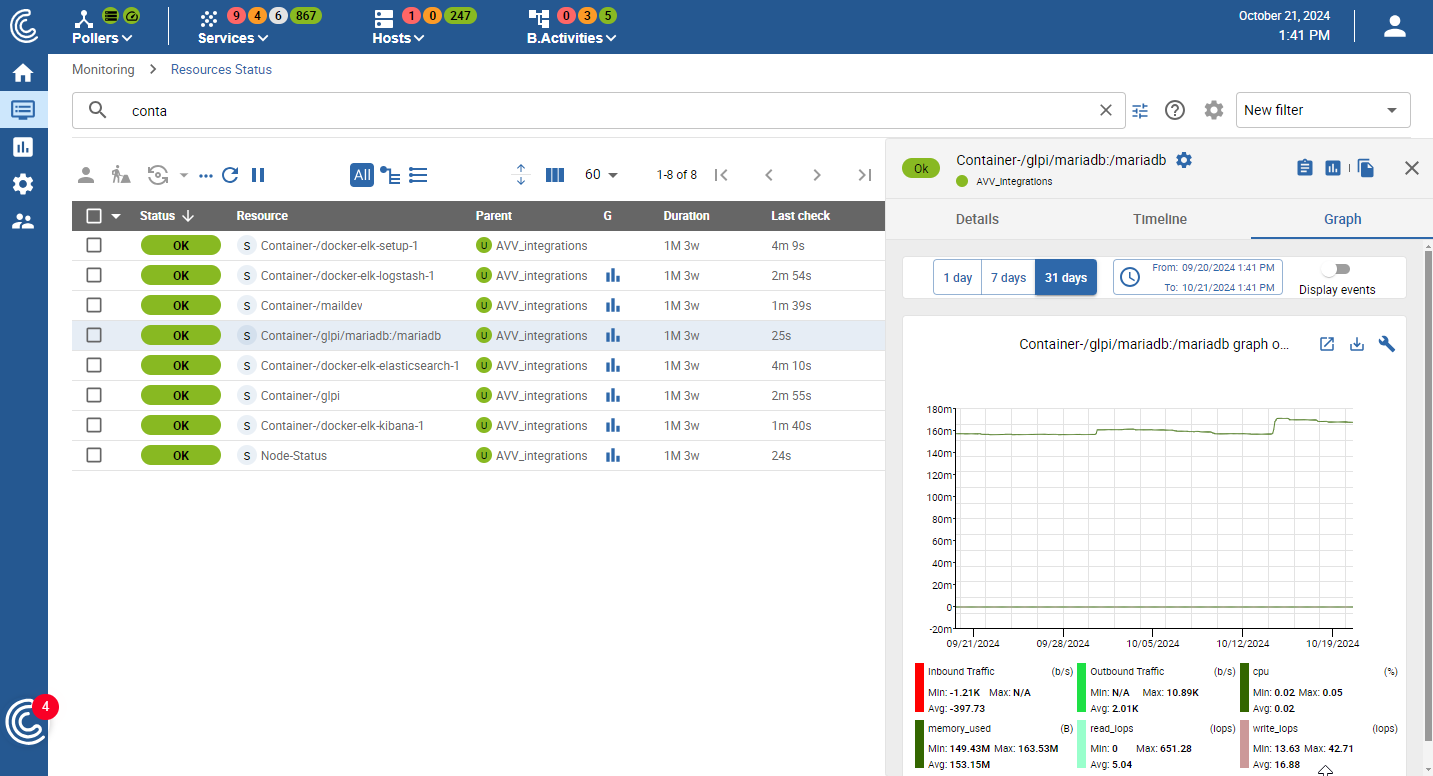
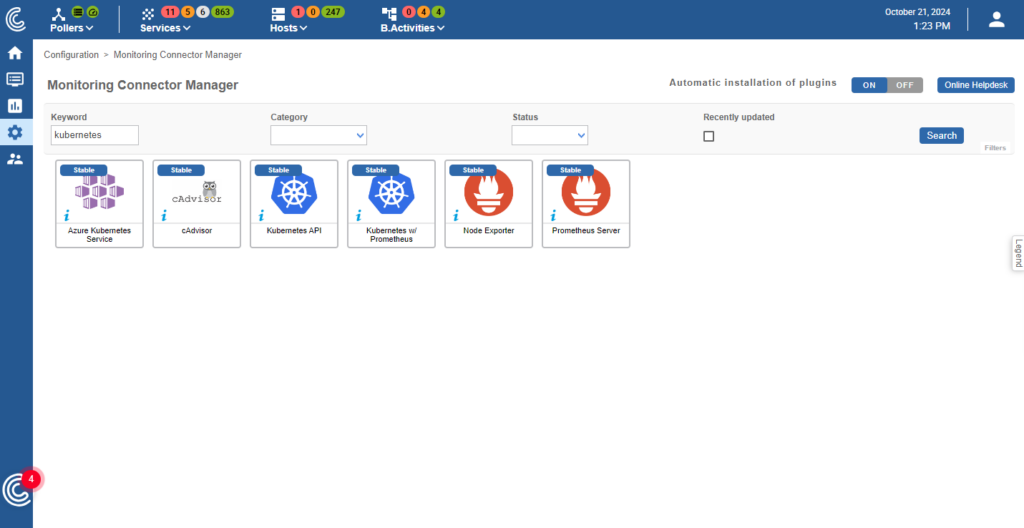
Automated Kubernetes Monitoring
Centreon’s Kubernetes connectors automatically discover and collect metadata and performance metrics from various Kubernetes components, ensuring proactive monitoring. Centreon can answer key operational questions, such as:
- Namespaces: Are all virtual clusters available and functioning?
- Nodes: Are nodes ready and scheduling pods as expected?
- Deployments: Are all deployments running according to their desired state?
- Daemonsets: Are daemonsets up and running across all nodes?
- Pods: What is the state of pods (ready, running, terminated, waiting)? How many times have they restarted? What are the reasons for failures?
- Volumes: Are persistent volumes healthy and accessible?
Centreon can also monitor the underlying infrastructure, whether it runs on physical servers, virtual machines, or in the cloud.
Multi-Source Kubernetes Monitoring
Different Kubernetes environments may require different monitoring methods. Centreon supports multiple data sources, depending on your setup:
Additional integrations, such as Kubernetes with Prometheus or cAdvisor, enable the collection of detailed system metrics, such as CPU, memory usage, and network traffic. The Prometheus connector leverages PromQL queries to collect Kubernetes-specific data.
The Kubernetes API Connector interacts directly with the Kubernetes API or through the kubectl command-line interface.
For clusters running on Azure, the Azure Kubernetes Service Connector integrates directly with the Azure API to monitor Kubernetes workloads.
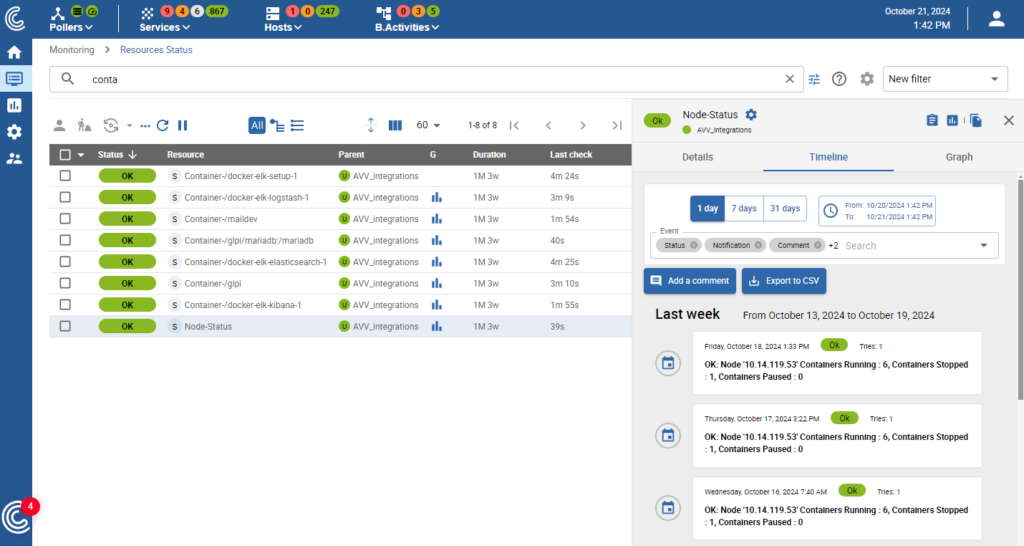
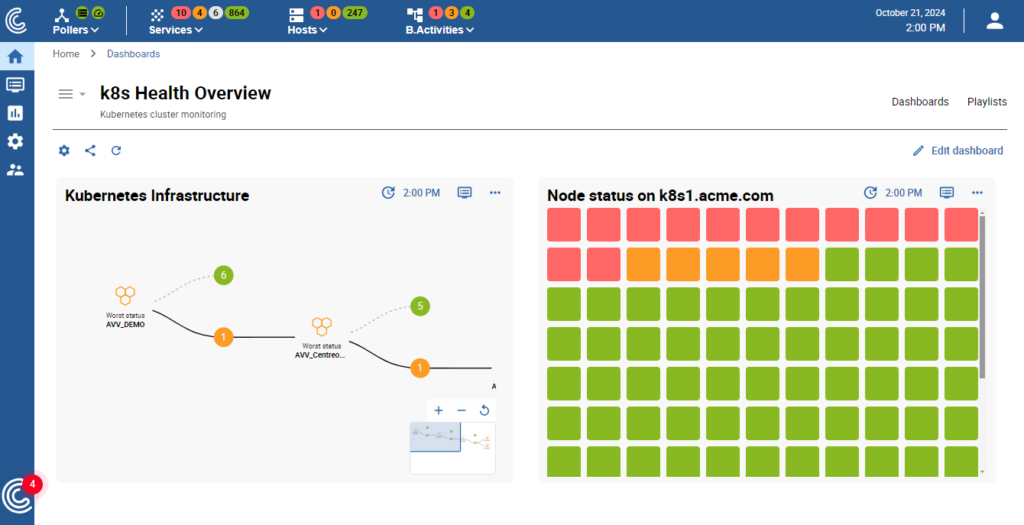
Dashboards and Alerts
Once Kubernetes data flows into Centreon, it is visualized through custom dashboards tailored to specific use cases, such as service weather maps or application maps. These dashboards allow teams to monitor the performance and health of Kubernetes clusters in real time.
Centreon’s Business Activity Diagrams provide additional insights into the interdependencies between systems, databases, APIs, and other components. This holistic view makes it easier to manage complex Kubernetes environments.
Furthermore, users can configure alerts to be triggered via email, PagerDuty, Slack, or Microsoft Teams, ensuring that incidents are responded to promptly.
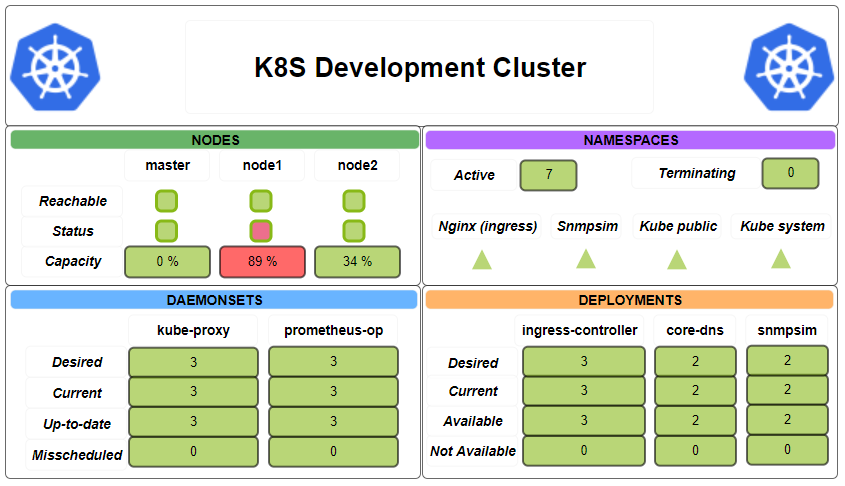
CENTREON BENEFITS
Centreon Benefits for Kubernetes (K8s) Monitoring

Comprehensive Could Monitoring
Centreon monitors private and public cloud technologies, including IaaS and SaaS, in multi-cloud environments: Amazon Web Services, Microsoft Azure and Google Cloud Platform.

True IT and Business Alignment
Centreon drives business performance excellence, aligning IT operations with business objectives through intuitive monitoring, including SLA Management, Decision Support and Collaborative Views.

Extensive Integrations
Centreon’s near-infinite integration possibilities enable a tailor-made and comprehensive observability environment that no other integrated monitoring solution can provide.
More from Centreon
Ready to see how Centreon can transform your business?
Keep informed on our latest news


